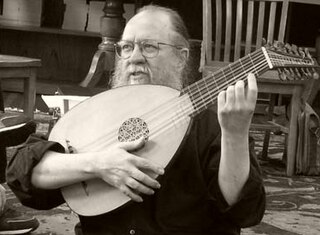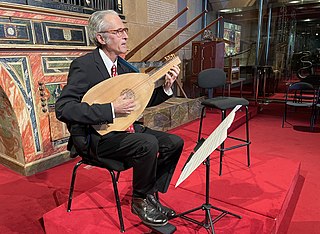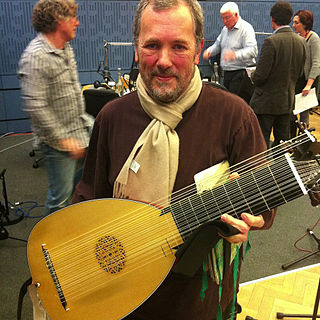Related Research Articles

John Dowland was an English Renaissance composer, lutenist, and singer. He is best known today for his melancholy songs such as "Come, heavy sleep", "Come again", "Flow my tears", "I saw my Lady weepe", "Now o now I needs must part" and "In darkness let me dwell", but his instrumental music has undergone a major revival, and with the 20th century's early music revival, has been a continuing source of repertoire for lutenists and classical guitarists.

A lute is any plucked string instrument with a neck and a deep round back enclosing a hollow cavity, usually with a sound hole or opening in the body. It may be either fretted or unfretted.

Patrick O'Brien was an American guitarist and lutenist born in New York. He was a recording artist, but was best known as a pedagogue in the field of early plucked instruments in America, and an expert in musicians' hand anatomy. He has worked with musicians on many instruments, reworking their technique around repetitive stress injuries and breakdowns of coordination.

Sylvius Leopold Weiss was a German composer and lutenist.
The Baltimore Consort is a musical ensemble that performs a wide variety of early music, Renaissance music and music from later periods. They began in 1980 as a group specializing in music of the Elizabethan period, but soon expanded their repertoire to include Scottish music, broadside ballads, and Italian, French, and other European music of the 16th and 17th centuries. Their music bridges the genres of classical and folk music.
Robert Johnson was an English composer and lutenist of the late Tudor and early Jacobean eras. He is sometimes called "Robert Johnson II" to distinguish him from an earlier Scottish composer. Johnson worked with William Shakespeare providing music for some of his later plays.

Hopkinson Smith is an American lutenist and pedagogue, longtime resident in Basel, Switzerland.
Jan Antonín Losy, Count of Losinthal ; also known as Comte d'Logy, was a Bohemian aristocrat, Baroque lute player and composer from Prague. His lute works combine the French style brisé with a more Italian cantabile style. He was probably the most significant lutenist-composer in Bohemia at the height of the lute's popularity there.
Bernhard Joachim Hagen was a German composer, lutenist and violinist. He was the last important composer of lute music in 18th-century Germany.
Luca Pianca is a Swiss musician-lutenist whose specialty is archlute. In 1985 he co - founded Il Giardino Armonico., a pioneering Italian early-music ensemble based in Milan. He has premiered works by the contemporary lutenist-composer Roman Turovsky-Savchuk at international festivals, and received numerous international awards for his recordings.

The Schola Cantorum Basiliensis (SCB) is a music academy and research institution located in Basel, Switzerland, that focuses on early music and historically informed performance. Faculty at the school have organized performing ensembles that have made notable recordings of early music. One of the more popular of these is the 1994 album Chill to the Chant.
Terrell Stone is an American lutenist and recording artist. He is a longtime resident of Italy, where he holds the position of a Professor of lute.

Nigel North is an English lutenist, musicologist, and pedagogue.
Toyohiko Satoh is a Japanese lutenist and composer.
Giovanni Paolo Paladino or Jean-Paul Paladin was an Italian composer and lutenist from Milan. He was born Giovanni Paolo Paladino and was also a merchant who maintained a large house and vinyard in Lyons. From 1516-22 he was lutenist to Francois I, from 1544 with Charles III of Lorraine, and from 1548-53 with Queen Mary of Scotland. Paladino published three books of lute music in Lyons in 1549, 1553 and 1560.
Ronn McFarlane is an American lutenist and composer, most notable as an interpreter of Renaissance music. He formerly taught lute at the Peabody Conservatory, and has recorded many albums as a solo performer and in collaboration with others, including the groups Ayreheart and The Baltimore Consort, and as a guest artist for countless other groups. He resides in Portland, Oregon, and continues to perform and compose to this day.
Anthony Bailes is a British lutenist.
Peter Croton is a Swiss-American lutenist and guitarist. He has attained prominence in his field through his numerous recordings, performances, publications, and teaching engagements. His recorded repertoire includes music from the Renaissance, Baroque and Classical periods, as well as his own compositions. His publications include a figured bass manual for classical guitarists and publications of compositions for voice and lute.
Antoine Francisque was a 16th-century French lutenist and composer.
Ian Harwood was a lutenist, musical instrument maker and teacher.
References
- ↑ Sonatas, B.V. (2005). "Authors of Articles in this Issue". Music and Letters. 86 (3).
- ↑ "Lute Music" . Retrieved 28 December 2011.
- ↑ Spring, Matthew (2006). The Lute in Britain: A History of the Instrument and Its Music. p. 117.
- ↑ "The Lute: the journal of the Lute Society". 45. Lute Society (Great Britain). 2007.
{{cite journal}}: Cite journal requires|journal=(help) - ↑ Smith, Douglas Alton Smith (2002). A history of the lute from antiquity to the Renaissance. Lute Society of America.